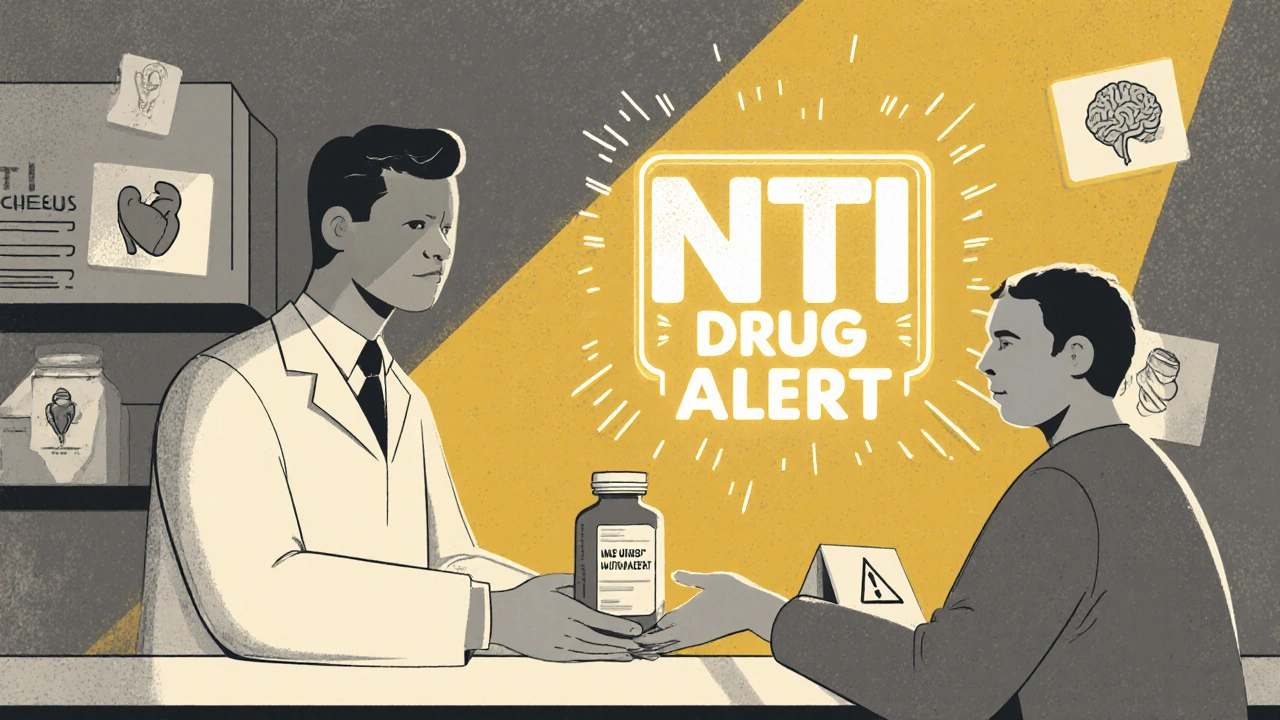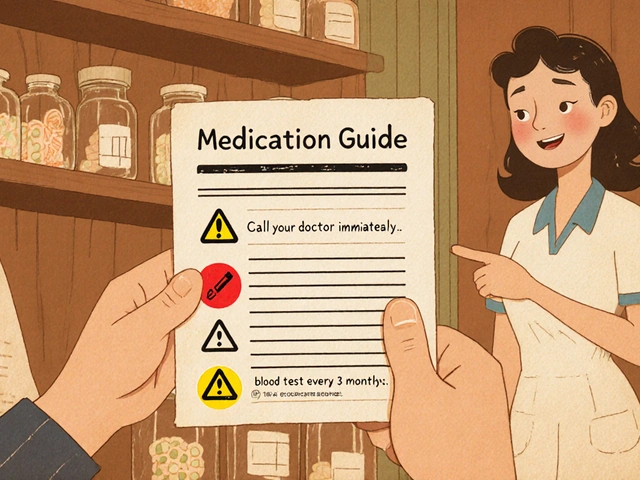When Doctors Adjust Doses After Switching to Generic Medications
When your doctor switches your medication from a brand-name drug to a generic version, you might assume nothing changes-same pill, same effect. But for some drugs, even a small switch can trigger big problems. Generic drugs are required by law to be bioequivalent to their brand-name counterparts, meaning they deliver the same active ingredient at the same rate and amount. But for a small group of medications known as narrow therapeutic index (NTI) drugs, that legal standard isn’t always enough to keep patients safe.
What Makes a Drug a Narrow Therapeutic Index (NTI) Drug?
NTI drugs have a razor-thin margin between a dose that works and one that’s dangerous. A little too much can cause toxicity; a little too little can mean the treatment fails. Think of it like walking a tightrope-no room for wobbling.
Examples include:
- Warfarin (blood thinner)
- Levothyroxine (thyroid hormone)
- Phenytoin and carbamazepine (anti-seizure meds)
- Tacrolimus and cyclosporine (immunosuppressants after transplants)
- Digoxin (heart medication)
The FDA defines NTI drugs as those where small changes in blood concentration can lead to serious side effects or loss of effectiveness. For these drugs, the target blood level often needs to stay within 20-30% of the ideal range. That’s why even tiny differences in how a generic is made-like the filler, coating, or how fast it dissolves-can matter.
Why Do Dose Changes Happen After Switching?
Generic drugs must prove they’re bioequivalent by showing their blood levels fall within 80-125% of the brand-name drug. That sounds precise, but for NTI drugs, that range is too wide. A 125% difference means a patient could get 25% more drug than expected-enough to cause bleeding with warfarin or toxicity with digoxin.
Real-world data shows this isn’t theoretical:
- In one study, 23% of patients on warfarin who switched between generic versions had unstable INR levels within 30 days, needing dose changes.
- After switching from brand to generic tacrolimus, nearly 19% of transplant patients needed dose adjustments within two weeks.
- For levothyroxine, patients often report fatigue, weight gain, or heart palpitations after a switch-even when labs show "normal" TSH levels. Many doctors now recommend staying on the same generic brand once stabilized.
These aren’t rare cases. A 2022 survey of hospital pharmacists found that 68% had seen patients need dose changes after switching NTI generics. The most common culprits? Antiepileptics, warfarin, and immunosuppressants.
When Should You Worry? Signs Your Dose Might Need Adjusting
If you’re on an NTI drug and your pharmacy switches your prescription to a different generic, watch for these signs:
- Warfarin: Unexplained bruising, nosebleeds, dark stools, or dizziness.
- Levothyroxine: New fatigue, weight gain, constipation, or cold intolerance.
- Phenytoin: Slurred speech, shaky hands, confusion, or new seizures.
- Tacrolimus: Tremors, headaches, high blood pressure, or kidney changes.
These symptoms don’t always mean your dose is wrong-but they’re red flags. Don’t wait for your next appointment. Call your doctor or pharmacist if you notice anything unusual within the first two weeks after a switch.

What Doctors and Pharmacies Are Doing About It
Many hospitals and academic medical centers now have strict policies for NTI drugs:
- Therapeutic drug monitoring (TDM): Blood tests to check drug levels before and after a switch. For tacrolimus, levels are often checked 3-7 days after switching.
- Staying on the same product: Once a patient is stable on a specific brand or generic, many providers avoid switching again-even if insurance changes.
- Formulary restrictions: Some institutions only allow one generic version of levothyroxine or warfarin to be stocked, reducing the chance of accidental switches.
- Clinical alerts: Electronic health records now flag NTI drugs and remind prescribers to check labs after a switch.
Insurance companies still push for the cheapest option, but providers are pushing back. A 2023 survey found 68% of academic medical centers restrict automatic generic switches for NTI drugs. Community pharmacies? Only 32% do the same.
What You Can Do: A Simple Action Plan
You don’t need to be a doctor to protect yourself. Here’s what to do if you’re on an NTI drug:
- Know your drug. Is it on the NTI list? Ask your pharmacist or look up your medication in the FDA’s Orange Book.
- Ask about the brand. If you’re stable on a specific generic, ask if you can keep it. Some insurers will approve it if you explain the risk.
- Track your symptoms. Keep a simple log: energy, sleep, mood, side effects. Note the date of any switch.
- Get tested. For warfarin, ask for an INR check 7-14 days after a switch. For levothyroxine, request a TSH test in 4-6 weeks.
- Speak up. If you feel worse after a switch, don’t assume it’s "just stress." Say: "I switched generics last week and I’m not feeling right. Can we check my levels?"
One patient, after switching from Synthroid to a generic levothyroxine, gained 15 pounds and felt exhausted. Her TSH was normal-but her doctor, aware of the issue, increased her dose by 12.5 mcg. Within two weeks, she felt like herself again.
The Bigger Picture: Why This Matters
NTI drugs make up only about 11% of the generic market-but they account for billions in annual spending and critical, life-sustaining treatments. The FDA is considering tightening bioequivalence standards for these drugs to 90-111%, instead of 80-125%. That change, expected in 2024, could reduce the need for dose adjustments in the future.
Meanwhile, some generic manufacturers are stepping up. Companies like Teva and Aurobindo now make "supergeneric" versions of NTI drugs with tighter quality controls, showing less variability in how they’re absorbed.
But until those improvements become standard, the burden falls on patients and providers. The goal isn’t to scare people away from generics-it’s to make sure the savings don’t come at the cost of safety.
Frequently Asked Questions
Do all generic drugs need dose adjustments after switching?
No. Most generic drugs-like those for high blood pressure, cholesterol, or diabetes-can be switched without any issue. The risk is only for narrow therapeutic index (NTI) drugs, which make up a small but critical group. If your drug isn’t on the NTI list, you’re likely fine.
Can I ask my pharmacy to keep me on the same generic brand?
Yes. You can request a "do not substitute" note on your prescription, or ask your doctor to write "dispense as written" (DAW) on the script. Many insurers will approve this if you explain you’re on an NTI drug and have been stable on a specific version.
How long after switching should I get my blood tested?
For warfarin: check INR within 7-14 days. For levothyroxine: TSH test at 4-6 weeks. For tacrolimus or phenytoin: blood levels should be checked within 3-7 days. Always confirm with your provider-the timing can vary based on your condition and how quickly your body processes the drug.
Is it safe to switch back and forth between generics?
It’s not recommended for NTI drugs. Each switch carries a risk of instability. Even if two generics are both "FDA-approved," they can differ slightly in how they’re absorbed. Stick with one version once you’re stable.
What if my insurance forces me to switch?
You can appeal. Ask your doctor to write a letter of medical necessity explaining that switching could cause harm. Many insurers will override the switch if you provide clinical evidence. Keep records of any symptoms or lab changes after a switch-they strengthen your case.
What Comes Next?
If you’re on an NTI drug and haven’t checked in with your doctor since your last generic switch, schedule a quick appointment. Bring your medication list and note any recent changes in how you feel. If you’re switching soon, ask about pre- and post-switch lab tests.
The system isn’t perfect. But awareness, communication, and a little vigilance can prevent serious problems. You’re not being difficult by asking for stability-you’re being smart.







10 Comments
DENIS GOLD
November 29, 2025 at 07:29
Oh wow, another ‘big pharma is evil’ sob story. 🤡 The FDA’s 80-125% range? That’s not a loophole-it’s a safety buffer. If your body can’t handle a 25% swing, maybe you’re the problem, not the generic. I’ve been on generics for 15 years and I haven’t turned into a zombie. Stop whining and take your damn pills.
Also, ‘supergeneric’? Sounds like a Marvel villain. Next they’ll patent ‘organic aspirin’ and charge $500 a bottle.
jobin joshua
November 30, 2025 at 03:05
Brooo 🤯 I just switched my levothyroxine last week and now I’m like 😴💤 tired all day 😭 my dog even noticed I’m not my happy self anymore 🐶💔
pls tell me I’m not alone 😭😭😭
Diana Askew
November 30, 2025 at 08:09
They’re hiding something. The FDA doesn’t want you to know that generics are made in China with contaminated fillers. I read a Reddit thread from 2018 where someone said the same thing happened to their mom after she switched to generic warfarin-and then she disappeared. No one ever found her body. Coincidence? I think not.
Also, the government owns the patent on your thyroid. They’re slowly replacing your hormones with nanobots to control your mood. That’s why your TSH is ‘normal’-it’s being faked.
Check your pills under UV light. If they glow blue, you’re being watched. 🕵️♀️🩸
Pawittar Singh
December 1, 2025 at 06:03
Hey everyone, I get it-switching meds is scary, especially when your life depends on it 💪❤️
But don’t panic! I’ve been on tacrolimus for 8 years after my kidney transplant, and I switched generics 4 times. Each time, I asked my pharmacist for the batch number, kept a symptom journal, and got my blood drawn 5 days later. No drama.
Trust your docs. Talk to your pharmacy. You’re not alone. And if you’re feeling off? That’s your body talking-listen to it 🙌
Also, if you’re in India, ask for Aurobindo-it’s the same as the US brand, way cheaper, and I’ve seen 100+ patients do fine with it. You got this! 💯
Josh Evans
December 1, 2025 at 21:10
Yeah I switched from Synthroid to a generic levothyroxine last year and didn’t notice anything. But then again, I didn’t check my TSH for 6 months so maybe I’m just lucky. My doc said if you feel fine, don’t fix it. But if you’re weirded out, get tested. Easy peasy.
Also, my pharmacy gives me the same generic every time now. No drama. Just ask.
TL;DR: Know your drug. Track your feelings. Talk to your pharmacist. Done.
Allison Reed
December 2, 2025 at 12:31
This is such an important topic-and so under-discussed. Thank you for laying this out so clearly. I’m a nurse, and I’ve seen patients get admitted for digoxin toxicity after a pharmacy switch. It’s not paranoia. It’s pharmacology.
The fact that 68% of hospital pharmacists report dose changes after NTI switches? That’s not a glitch. That’s a system failure.
Patients shouldn’t have to be medical detectives just to stay alive. We need better standards, better labeling, and better communication. And yes-we need to stop treating NTI drugs like they’re ibuprofen.
Keep speaking up. You’re helping people.
Jacob Keil
December 3, 2025 at 18:59
so like… if the FDA allows 80-125% bioequivalency… then technically… a generic could be 25% weaker OR 25% stronger… which means… the drug you take today… might be a different drug tomorrow?
is this… capitalism? or is this… the government letting corporations poison us to save 20 cents?
i think we’re all just lab rats in a giant pharmacy experiment and no one told us we signed up for this.
also i think the moon landing was fake and the earth is flat but i’m not sure anymore
someone please tell me i’m not crazy
Andrea Jones
December 4, 2025 at 09:43
Oh honey, I’ve been there. Switched from brand to generic levothyroxine and suddenly I was sleeping 12 hours a day and crying over cereal commercials.
Went to my doc, said ‘I don’t feel like me.’ She didn’t even blink. Ordered a TSH. Mine was 8.5. Normal range is 0.5–4.5. I was basically in thyroid hibernation.
Switched back to the same generic I was on before-boom. Energy returned. No drama.
So here’s the thing: if you feel off after a switch? It’s not ‘just stress.’ It’s your body screaming. Don’t wait. Don’t apologize. Say: ‘I need a blood test.’
And if your pharmacist gives you side-eye? Tell them you’re not a lab rat. You’re a person.
You’re not being difficult. You’re being wise.
Justina Maynard
December 5, 2025 at 04:50
Let’s be real-this isn’t about generics. It’s about the slow death of trust in healthcare.
When you’re told your medication is ‘equivalent’ but your body screams otherwise, you start questioning everything. Is my doctor lying? Is my pharmacist just rushing? Is the FDA asleep? Is my insurance company running a human experiment?
I used to think ‘FDA-approved’ meant ‘safe.’ Now I know it just means ‘legally allowed to be sold.’
And the worst part? The people who suffer most are the ones who can’t afford to keep paying for the brand. So we’re punished for being poor.
Maybe the real NTI drug… is the American healthcare system.
Evelyn Salazar Garcia
December 6, 2025 at 20:02
Stop making this a thing. Just take the pill.
My grandma took generics for 40 years and never complained. You’re weak.